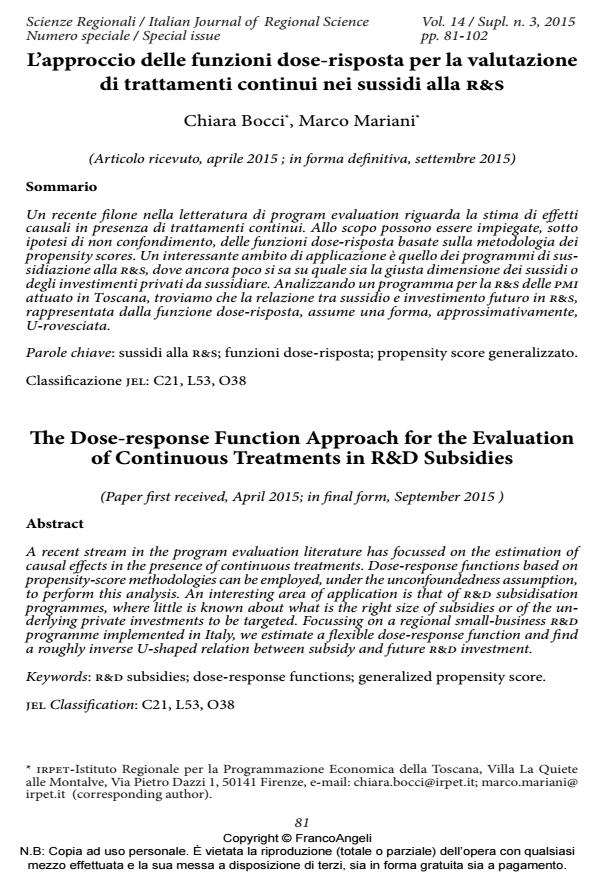L’approccio delle funzioni dose-risposta per la valutazione di trattamenti continui nei sussidi alla r&s
Titolo Rivista SCIENZE REGIONALI
Autori/Curatori Chiara Bocci, Marco Mariani
Anno di pubblicazione 2015 Fascicolo 2015/3 Suppl.
Lingua Italiano Numero pagine 22 P. 81-102 Dimensione file 386 KB
DOI 10.3280/SCRE2015-S03005
Il DOI è il codice a barre della proprietà intellettuale: per saperne di più
clicca qui
Qui sotto puoi vedere in anteprima la prima pagina di questo articolo.
Se questo articolo ti interessa, lo puoi acquistare (e scaricare in formato pdf) seguendo le facili indicazioni per acquistare il download credit. Acquista Download Credits per scaricare questo Articolo in formato PDF

FrancoAngeli è membro della Publishers International Linking Association, Inc (PILA)associazione indipendente e non profit per facilitare (attraverso i servizi tecnologici implementati da CrossRef.org) l’accesso degli studiosi ai contenuti digitali nelle pubblicazioni professionali e scientifiche
Un recente filone nella letteratura di program evaluation riguarda la stima di effetti causali in presenza di trattamenti continui. Allo scopo possono essere impiegate, sotto ipotesi di non confondimento, delle funzioni dose-risposta basate sulla metodologia dei propensity scores. Un interessante ambito di applicazione è quello dei programmi di sussidiazione alla r&s, dove ancora poco si sa su quale sia la giusta dimensione dei sussidi o degli investimenti privati da sussidiare. Analizzando un programma per la r&s delle pmi attuato in Toscana, troviamo che la relazione tra sussidio e investimento futuro in r&s, rappresentata dalla funzione dose-risposta, assume una forma, approssimativamente, U-rovesciata.
Parole chiave:Sussidi alla r&s; funzioni dose-risposta; propensity score generalizzato.
Jel codes:C21, L53, O38
- The Effects of R&D Subsidies to Small and Medium-Sized Enterprises. Evidence from a Regional Program Marco Mariani, Fabrizia Mealli, in Italian Economic Journal /2018 pp.249
DOI: 10.1007/s40797-017-0062-2 - A comparative evaluation of regional subsidies for collaborative and individual R&D in small and medium-sized enterprises Annalisa Caloffi, Marco Mariani, Federica Rossi, Margherita Russo, in Research Policy /2018 pp.1437
DOI: 10.1016/j.respol.2018.04.022 - Place-based policy in southern Italy: evidence from a dose–response approach Alessandro Cusimano, Fabio Mazzola, Sylvain Barde, in Regional Studies /2021 pp.1442
DOI: 10.1080/00343404.2021.1902974
Chiara Bocci, Marco Mariani, L’approccio delle funzioni dose-risposta per la valutazione di trattamenti continui nei sussidi alla r&s in "SCIENZE REGIONALI " 3 Suppl./2015, pp 81-102, DOI: 10.3280/SCRE2015-S03005